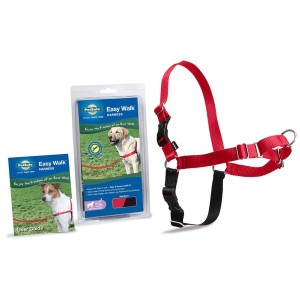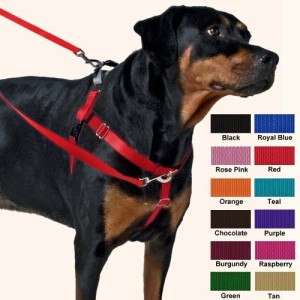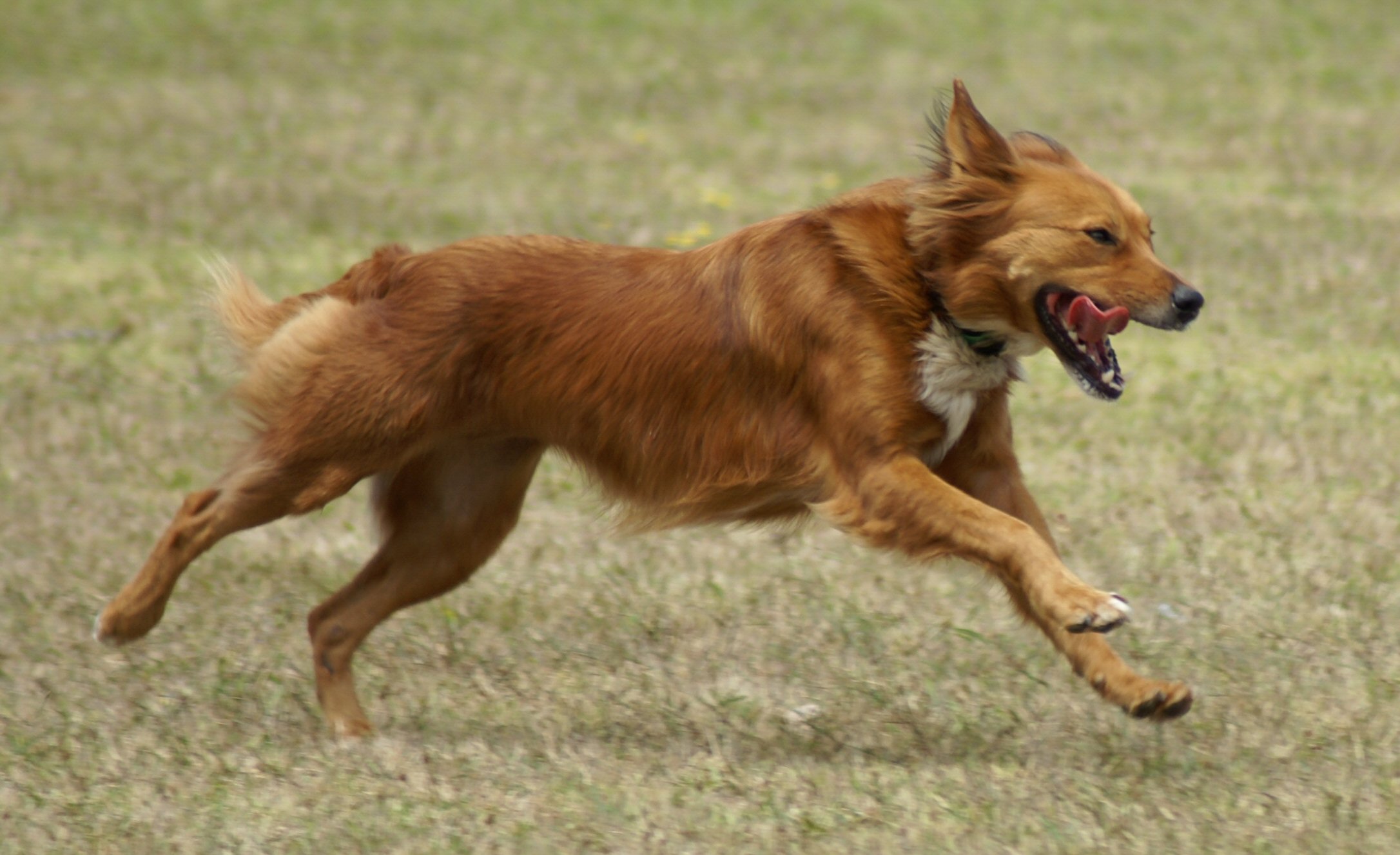Last Updated on October 30, 2023
When we walk our dogs, owners usually put the dog on a leash. Now the question is whether to use a simple collar on the dog or a harness on it. The main difference between a collar and a harness is that harness provides control over the dog to the owner. Also, the harness is safer as compared to collars. Imagine the amount of pressure there is on the neck of the dog if she is wearing a collar and pulling you along at the same time! This is why we would like to review some of the best harnesses for pullers in this article.
Best Harness For Pullers
There are different variations of harnesses in the market for dogs, and each of them plays a specific role. It will be good to know and understand the functions of the various types of harnesses before you decide on the best harness for pullers.
Various Types of Harness
Back-Clip Harness

Back-Clip Harness can be easily identified via the ring connecting the harness to the leash. If the ring is located at the top, then it is a Back-Clip Harness.
The Back-Clip Harness is by far the most popular harness amongst owners who bring their dogs for frequent walks. This harness is usually for dogs who are trained not to pull as the harness doesn’t discourage pulling. This harness doesn’t tangle the leash as much as the other harness does.
Below are 2 of the more popular Front-Clip Harness available.
No-Pull Dog Leash Harness, ARIKON Adjustable and Heavy Duty Denim Dog Training Walking Leash Collar for Large Dog
This Range of Back-Clip Harness is the top seller in Amazon. It comes in different sizes, from small to large. If your dog isn’t too aggressive, then this might be the best dog harness for pullers.
The harness, which is made of strong, water-resistant denim cloth, is adjustable using the plastic rings. The entire setup was designed to ensure maximum toughness while not compromising on its ability to control your pet effectively.
To prevent allergic reactions, please do wash the harness before using it for the first time.
This harness has rave reviews online. Many pet owners reviewed that their pets were completely restrained while using this harness as compared to other inferior products. Also, the unique color combination makes it a standout against other harnesses too.
Pros: Maximum control over your dog.
Cons: Not meant for aggressive dogs.
Our Rating: [usr 4.8]
Ruffwear Front Range Harness, Large/X-Large, Pacific Blue
Another popular Back-Clip harness is the one made by Ruffwear. This Back-Clip Harness
This harness can be put onto your dog without much trouble. It is comfortable and the padded chest and belly panel distributes the load evenly. There are two leash attachment points; One of it is at the V-ring on the dog’s back, and the other is on the reinforced webbing on the dog’s chest.
This is the top choice for the best harness for pullers for professional dog trainers. It can function either like a Back-Clip Harness or a Front-Clip Harness. It is constructed from high-quality materials, and it is ensured to provide comfort for the dog. You can use the back-clip for runs and front-clip for walks. If your dog is quite a puller, than you can use both for added security.
Pros: Comfortable padding for your dog. Good control over aggressive dogs.
Cons: Limited designs.
Our Rating: [usr 4.9]
Front-Clip Harness or Step-In Harness
 Front-Clip Harness can be identified if the ring is at the center of the dog’s chest. This harness is good for dogs who constantly pull the owner when going for walks. It gives the owner a good control over the dog’s direction. The owner can also re-position the dog as and when necessary.
Front-Clip Harness can be identified if the ring is at the center of the dog’s chest. This harness is good for dogs who constantly pull the owner when going for walks. It gives the owner a good control over the dog’s direction. The owner can also re-position the dog as and when necessary.
Although the Front-Clip Harness does prevent pulling from the dog, the leash that is attached to the ring can tangle under the dog’s legs.
One of the most popular dog harnesses that qualifies as the best harness for pullers is Walk In Sync Sport Harness & Leash.
This Front-Clip Harness by Walk In Sync is mainly catered for training dogs to stop pulling or to teach a puppy the basics of walking with the owner. It doesn’t entirely restrict the movement of the dog, but at the same time provide added security in controlling your dog too.
Designed by a professional holistic dog trainer, this Front-Clip Harness does not choke your dog, hence reducing the risk of injury or induced aggression in your dog.
Pros: Does not choke your dog. Good for training dog
Cons: Not large extremely strong pullers.
Our Rating: [usr 4.7]
Tightening Harness

Tightening Harness is a variation of the front-clip harness, just that the mechanism of the harness discourages the dog from pulling away from you. When the dog runs, the harness will tighten and add pressure to the dog. The additional pressure will be uncomfortable for the dog, causing it to stop pulling away from you. However, some of the harnesses can inflict excessive pain on the dog, which is extremely bad as it can induce aggression in an otherwise docile dog.
Tightening Harnesses are the most popular harness in the market as it really restricts the pulling effect from even the largest dog. Below are some of the most reviewed Tightening Harnesses found online.
PetSafe Easy Walk Dog Harness, Large, Red/Black
This range of Tightening Harness by PetSafe is very popular with many pet owners. The front clip allows the owner to steer the dog while reducing the chances of the dog pulling during walks. The chest strap is designed to reduce the dog chances of choking.
This simple harness works by putting the stress on the shoulders instead of the usual stress points on the neck. When the dog tries to run away, the pressure ensures to discourage the dog. The two-point adjustment allows it to be fitted nicely on the dog.
Pros: Allows you to steer the dog around to your desired direction.
Cons: Simple design.
Our Rating: [usr 4.6]
Freedom No-Pull Dog Harness Training Package
This Tightening Harness is patented by Wiggles Wags & Whiskers. It is actually made up of industrial strength nylon webbing, and that really means that the harness is nearly indestructible by the dog. Like all Tightening Harnesses, Freedom No-Pull Dog Harness discourages the dog from pulling forward. You could either hook the leash to the back or to the front, depending if you intend to train the dog, or the dog is properly trained already.
Pros: Chew resistant.
Cons: Meant for larger dogs.
Our Rating: [usr 4.8]
Last but not least, if your dog is very strong, then your solution perhaps will be Newbury Paws Classic Harness, Premium Dog Harness for Large Breed Dogs.
This Harness is a perfect fit for large dogs that require additional effort to control while walking them. The high-quality materials eradicate pulling and neck strain.
One interesting point is that the company seek the consultation of a canine physical therapist, so this Harness can be guaranteed to work extremely well.
We love this because it looks good on your large dog too.
Pros: High quality materials. A professional consultation was asked before designing this.
Cons: Limited designs.
Our Rating: [usr 4.7]
After reviewing the various harnesses, we recommend Ruffwear Front Range Harness, Walk In Sync Sport Harness & Leash. and Newbury Paws Classic Harness, Premium Dog Harness for Large Breed Dogs as the best harness for pullers in its respective categories.
As with all harness, we will need a quality leash to go with it. Look at the different types of leashes which are available in the market here. Or if you want to find out more, you can read this too.
What To Consider When Buying A Harness For Pullers
With so many different types of harnesses that are available for pullers, you might be spoilt for choice. In this sense, we have come up with some of the factors that you should consider before you purchase the harness for your dog.
- Adjustable Straps: Adjustable straps can ensure a secure and comfortable fit for your dog, especially if they are pullers. Look for harnesses with straps that can be adjusted around the chest, girth, and neck area. This will allow you to have a custom fit for your dog.
- Padding: Note that good padding is important for added comfort for your dog, especially if they will be wearing the harness for extended periods of time. Look for harnesses that have padded straps, especially around the chest and girth areas, to help prevent chaffing and rubbing. This is equally important given that your dog will still want to pull away from you.
- Front D-ring attachment: This feature helps to redirect your dog’s attention and discourages pulling. The front D-ring attachment is located on the chest of the harness and is used to attach the leash. This way when your dog pulls, it will turn around to face you, making it easier for you to control the dog and discourage the pulling behavior.
- Reflective Straps: Reflective straps are a great safety feature for nighttime walks. They make it easier for cars or even other people to see your dog in low light conditions. This can help to prevent accidents.
- Durable construction: Look for harnesses made of durable materials, such as nylon or heavy-duty polyester. This is to ensure the harness can withstand the wear and tear of regular use, which will surely be a norm given that the dog will still try to pull away from you.
- Breathable mesh: Some no-pull harnesses come with a breathable mesh inner lining which will make the harness more comfortable for your dog to wear during the summer or hot weather.
- Escape-proof mechanism: Some no-pull harnesses have an escape-proof mechanism, which makes it difficult for your dog to slip out of the harness. This feature can be especially useful for dogs that are known to be escape artists, or if your dog is extremely strong.
How to use a no-pull harness to prevent your dog from lunging at other dogs or people
Using a no-pull harness can be an effective way to prevent your dog from lunging at other dogs or people. Here are the steps to properly use a no-pull harness for this purpose:
- Choose the Right Harness: Select a no-pull harness that’s appropriate for your dog’s size and breed. Measure your dog’s girth (the widest part of their chest) and use the manufacturer’s sizing chart to ensure a snug, comfortable fit.
- Introduce the Harness: Before using the harness for training, allow your dog to become familiar with it. Let them sniff and explore it, associating the harness with positive experiences like treats, praise, and play.
- Proper Fitting: Adjust the harness according to your dog’s size, making sure it’s snug but not too tight. You should be able to comfortably fit two fingers between the harness and your dog’s skin.
- Practice in a Controlled Environment: Start your training in a controlled, low-distraction environment. This could be your backyard, a quiet park, or a designated training area.
- Positive Reinforcement: Use positive reinforcement techniques. When your dog walks without pulling, reward them with treats, toys, and verbal praise. This helps them associate the desired behavior with rewards.
- Start with Basic Training: Begin teaching your dog basic commands such as “heel” (walking calmly by your side) and “leave it” (ignoring distractions). These commands will help you redirect your dog’s attention when they begin to pull or lunge.
- Gradual Exposure: Slowly expose your dog to the triggers (other dogs or people) from a distance where they can remain calm. Reward your dog for staying calm and gradually decrease the distance to the trigger over time.
- Immediate Correction: When your dog starts to pull or lunge, use a gentle but firm correction. Do not yank or pull on the leash, as this can cause discomfort and fear. Instead, redirect your dog’s attention using the commands you’ve taught, and reward them when they respond appropriately.
- Consistency: Be consistent with your training. Use the no-pull harness every time you walk your dog, even in low-distraction environments. Consistency helps reinforce the desired behavior.
- Increase Distractions Gradually: As your dog becomes more skilled at walking without pulling, gradually expose them to more challenging distractions. This could mean walking closer to other dogs or people while maintaining control.
- Stay Patient: Training can take time, and every dog is unique. Be patient and understanding of your dog’s progress, and always maintain a calm and positive attitude during training sessions.
- Seek Professional Help: If your dog’s lunging behavior is severe or persistent, consider seeking assistance from a professional dog trainer or behaviorist. They can provide specialized guidance and techniques to address specific issues.
Remember that training your dog to walk calmly with a no-pull harness is a gradual process. It requires patience, consistency, and positive reinforcement to ensure your dog’s safety and well-being while preventing lunging at other dogs or people.
 Dog N Treats All dogs deserve to be pampered
Dog N Treats All dogs deserve to be pampered









